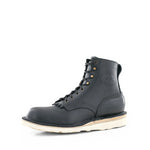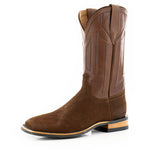Can Wildland Fire Boots Have a Steel Shank?
There’s a lot of false information out there saying that a steel shank conducts too much heat and can burn your feet if you’re out fighting fires and expose your boot sole to too many embers.
That’s just not true.
However, the best wildland fire boots like the JK Fire Inlander don’t use steel shanks. And there’s a good reason for it.
Can I Have a Steel Shank in my Wildland Fire Boot?

Short answer: yes, wildland firefighting boots can have a steel shank.
A steel shank is a supportive strip of, you guessed it: steel. It runs through the midsole of a boot to provide additional arch support and protection against puncture hazards.
In wildland firefighting, having a shank in your boot is necessary. You need some added arch support for those long 16 hour shifts where you’re raking in as much overtime pay as you can.
While a steel shank is fine, it’s not the best material shank for a wildland fire boot.
Leather is.
Why the JK Fire Inlander Uses a Leather Shank

A leather shank in a wildland fire boot can offer several benefits, although it is less common compared to steel, fiberglass, or composite shanks. Some benefits of a leather shank include:
- Comfort: Leather is a flexible and naturally conforming material that can provide a comfortable fit, especially when broken in. A leather shank conforms to the shape of the wearer's foot, providing a more customized fit and reduces foot fatigue during extended periods of wear.
- Lightweight: Leather shanks are generally lighter than steel, fiberglass, or composite shanks. This can help reduce the overall weight of the boots, which may be beneficial for firefighters who need to cover long distances or work for extended periods.
- Moisture Control: Leather is a naturally breathable material, which can help with temperature regulation and moisture management inside the boot. The pores of a leather shank contribute to improved breathability and comfort during long shifts in hot, dry conditions.
- Durability: High-quality leather is a durable material that can withstand tough conditions and wear over time. A leather shank may provide long-lasting support and protection for wildland firefighters.
5 Crucial Differences to Consider Between Leather and Steel Boot Shanks
When selecting the ideal pair of wildland firefighting boots, the choice between leather and steel shanks can make a world of difference.
1. Rigidity vs. Flexibility
Steel shanks provide enhanced rigidity, offering increased stability when hiking on uneven terrain or when carrying heavy loads. This added support can be advantageous in some situations, but it can also make the boot feel less flexible and comfortable compared to a leather shank.
On the other hand, leather shanks offer a more flexible and comfortable fit.
With wildland fire boots, you can expect a good pair to last many seasons. For that reason, a leather shank is going to be your best bet because it gets more comfortable over time.
2. Break-in Period and Comfort
Leather shanks typically boast a shorter break-in period than steel shanks. They adapt to your foot more quickly, resulting in a comfortable fit relatively quickly.
Steel shanks, however, may take more time and wear to achieve a similar level of comfort. If comfort is key, leather shanks are definitely the way to go.
3. Corrosion Resistance and Durability
Leather shanks are naturally resistant to corrosion and rust, making them ideal in wet or humid environments where moisture can cause steel shanks to degrade over time.
If durability and resistance to the elements are essential factors, leather shanks offer a clear advantage.
4. Electrical Hazard Protection
Boots with steel shanks can conduct electricity, posing a risk in certain situations. If electrical hazards are a concern in your line of work, get a non-metallic shank, such as leather, fiberglass, or composite materials, for added safety.
Here’s a full guide on the NFPA requirements for wildland fire boots if you want more information on this issue.
5. Cost Considerations
Typically boots with leather shanks cost more because the leather is a pricier material than steel. But considering the many advantages you get with a leather shank, it’s a worthwhile investment.
Steel Here?
A steel shank is fine in a pair of wildland fire boots, but it’s not the best option.
If you haven’t picked up a pair of boots for this season, we recommend the JK Fire Inlander. This boot is purpose-built specifically for wildland firefighters and we have hundreds of wildland fire operators in our boots right now.
You can read why JK Boots have a 4.9-star rating with over 450 reviews and find out why so many of our customers write to us telling us that the JK Fire Inlander is the only boot they’ll wear out on the job now.





















Hi cal fire will not let us allow five family room out not that one use the jk fire boots do to it not Nfpa certification. I have 4 other co workers that have bought the got the fire boots. Now we have to spend the money we don’t have on a new pair. Are guys going to get the nfpa certification?
Leave a comment